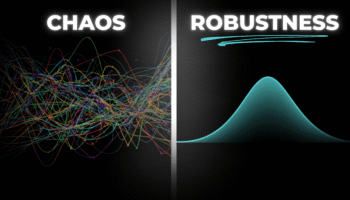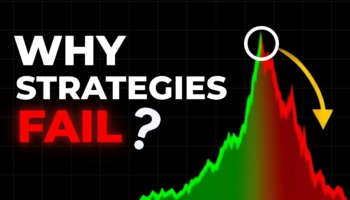
Why Manual Trading Will Always Fail You (And What to Do Instead)
Every time you click buy or sell, you’re competing against machines that never hesitate, never sleep, and never make emotional mistakes. I know this the hard way. I used to …
Přejít k obsahu | Přejít k hlavnímu menu | Přejít k vyhledávání
Before diving into specific indicators, we need to understand what Smart Money Concepts actually represent. Think of the financial markets as a game between two types of players: institutional traders (the “smart money”) and retail traders (individual investors like you and me). These two groups operate very differently, and understanding these differences can give us a significant edge.
Institutional traders – banks, hedge funds, and large financial organizations – trade with massive capital and sophisticated strategies. When they want to buy or sell large positions, they cannot simply place a market order like retail traders do. If a bank wants to buy 10 million dollars worth of a stock, placing that order all at once would immediately drive the price up, making their purchase much more expensive. Instead, they use complex techniques to hide their intentions and accumulate positions without revealing their hand.
Smart Money Concepts is a trading methodology that attempts to identify these institutional footprints in price action. The core idea is that by recognizing how institutions operate, we can position ourselves to trade alongside them rather than against them. This approach focuses on market structure, liquidity, and the psychology of institutional versus retail trading.
The four indicators we will explore – Fair Value Gap, Order Block Detector, Break of Structure, and Simple Liquidity Sweep – each capture different aspects of institutional behavior. Let me walk you through how each one works and what it reveals about market dynamics.
When you look at a price chart, you might assume that every price level has been fairly valued by the market. However, this is not always true. Sometimes price moves so quickly that it leaves behind “gaps” or imbalances where there was insufficient trading activity to establish fair value.
Think of it this way: imagine you are at an auction where bidding suddenly jumps from $100 to $150 with no bids in between. The $125 level represents a fair value gap – a price area that was skipped over and never properly tested by the market. In financial markets, these gaps often occur when institutions place large orders that cause rapid price movements.
The Fair Value Gap indicator identifies these imbalances by examining three consecutive candlesticks. When the middle candle shows strong directional movement that creates a gap between the first and third candles, we have identified a potential fair value gap. The key insight is that markets often return to fill these gaps later, providing trading opportunities.
Let me walk you through exactly how these gaps form step by step. Consider three consecutive candles: the first establishes a baseline price range, the middle candle shows strong directional movement (this represents institutional urgency), and the third candle continues in the same direction but creates a gap. The gap occurs when the current candle’s extreme doesn’t overlap with the price range from two periods ago.
For a bullish Fair Value Gap, institutions push prices up so aggressively that we see a bullish middle candle followed by continued upward movement where the current low is actually higher than the high from two bars ago. This gap represents price levels where no selling occurred – an imbalance that often attracts future selling interest when price returns.
For a bearish Fair Value Gap, aggressive institutional selling creates the opposite pattern. We see a bearish middle candle followed by further downside movement where the current high is actually lower than the low from two bars ago. This gap represents prices where no buying occurred – an imbalance that often attracts future buying interest.
The MinCandleSize parameter acts as a quality filter, separating genuine institutional moves from ordinary market noise. Think of it as a “significance threshold” that requires the current candle to be substantially larger than surrounding candles. When set to 1.5, the current candle must be at least 50% larger than both neighboring candles, ensuring the gap formed from genuine momentum rather than random fluctuations.
The StrategyQuant implementation provides two preset configurations:
Understanding the indicator output is straightforward. When you see a +1 signal, the indicator has detected a bullish fair value gap – an area below current price where buying interest may emerge if price returns to that level. A -1 signal indicates a bearish fair value gap above current price where selling pressure might appear. The 0 signal simply means no significant gap is present.
Download the Fair Value Gap Indicator: You can access this institutional imbalance detector from the StrategyQuant Codebase – Fair Value Gap. It’s available for MT4, MT5, TradeStation, and MultiCharts platforms.
Order blocks represent one of the most important concepts in Smart Money trading. To understand them, you need to think about how large institutions actually enter positions. When a bank wants to buy a large position, they often wait for price to decline to attractive levels before placing their orders. This creates clusters of buy orders at specific price levels.
Here is where it gets interesting: after institutions accumulate their positions, they typically want the price to move in their favor. This often creates strong directional moves away from these accumulation zones. The Order Block Detector identifies these zones by looking for areas where strong momentum candles emerge after periods of consolidation or minor structural breaks.
The indicator produces signals ranging from -2 to +2, giving us insight into both the direction and strength of institutional activity. When you see a +2 signal, the indicator has detected a very strong bullish order block – an area where significant buying interest likely exists. A +1 signal indicates a standard bullish order block with moderate institutional interest. The negative values work the same way but for selling interest.
What makes this indicator sophisticated is how it uses the Average True Range (ATR) to normalize momentum calculations. This ensures that what constitutes “strong momentum” is relative to the current market volatility. A move that seems large in a quiet market might be normal in a volatile market, and the ATR adjustment accounts for this.
The three key parameters work together to fine-tune detection. ATRPeriod determines how volatility is calculated, MomentumThreshold controls how strong a move needs to be to qualify as institutional activity, and SwingPeriod defines the lookback for structural analysis. For most applications, starting with ATRPeriod at 14, MomentumThreshold at 1.5, and SwingPeriod at 5 provides a good balance between sensitivity and reliability.
The StrategyQuant implementation includes two preset configurations to help you get started:
Download the Order Block Detector: You can get this indicator from the StrategyQuant Codebase – Order Block Detector. It’s available for MT4, MT5, TradeStation, and MultiCharts platforms.
Market structure is a fundamental concept that describes how price creates patterns of higher highs and higher lows in uptrends, or lower highs and lower lows in downtrends. When this structure breaks, it often signals that the underlying institutional sentiment has changed.
Think of market structure like the foundation of a building. As long as the foundation is intact, the building (the trend) remains stable. But when the foundation cracks (structure breaks), the entire building may be at risk of collapse. In trading terms, when an established pattern of higher highs breaks and price makes a lower high instead, it suggests that institutional buying interest may be waning.
The Break of Structure indicator monitors this structural integrity continuously. It defines structure based on a lookback period (the Period parameter) and then watches for significant breaks in that structure. However, not every break is meaningful – sometimes price briefly breaks structure only to immediately return to the previous pattern. This is why the indicator includes a MinMomentum requirement.
When you see a +1 signal, structure has been broken to the upside with sufficient momentum to suggest institutional buying. A -1 signal indicates structure has been broken to the downside with institutional selling pressure. The momentum requirement helps filter out false breaks that lack conviction.
The beauty of this approach is that it identifies trend changes relatively early in the process. Traditional trend-following indicators often lag significantly because they wait for trends to be well-established before generating signals. By focusing on structural breaks with momentum confirmation, this indicator can capture trend changes much closer to their inception.
The StrategyQuant implementation offers two preset configurations to help you adapt to different market conditions:
You can adjust the Period parameter based on your trading style. Shorter periods (5-15) work well for intraday scalping, while longer periods (20-50) suit swing trading approaches. The MinMomentum setting should reflect current market volatility – increase it during choppy conditions and reduce it during strong trending phases.
Download the Break of Structure Indicator: Get this powerful trend change detector from the StrategyQuant Codebase – Break of Structure. Available for MT4, MT5, TradeStation, and MultiCharts.
Liquidity sweeps represent perhaps the most cynical aspect of institutional trading, yet understanding them is crucial for retail trader success. Large institutions need liquidity (the ability to buy or sell large quantities) to execute their trades efficiently. They know that retail traders typically place stop-losses just beyond obvious levels like recent highs and lows.
Here is how the game works: institutions will sometimes push price slightly beyond these obvious levels to trigger retail stop-losses, creating a surge of liquidity. Once they have absorbed this liquidity, they often reverse price in the opposite direction. This creates what appears to be a false breakout to retail traders, but it is actually a calculated move to access liquidity.
The Simple Liquidity Sweep indicator identifies these patterns by monitoring when price moves beyond local highs or lows by a significant amount (the Threshold parameter multiplied by ATR) but then reverses and closes back inside the previous range. The ConfirmationBars parameter ensures that the reversal has staying power rather than being just a momentary correction.
When you see a +1 signal, price has swept below a local low (likely triggering long stop-losses) but then recovered and closed back above that low with confirmation. This suggests a bullish reversal opportunity. A -1 signal indicates the opposite pattern – a sweep above local highs followed by a confirmed reversal lower.
The ATR-based threshold adjustment is crucial because it ensures the indicator adapts to different market conditions. In volatile markets, larger moves are normal, so the threshold automatically increases. In quiet markets, smaller moves might be significant, so the threshold decreases accordingly.
Understanding the three preset configurations can help you choose the right setup for your trading approach:
The conservative setup works particularly well in volatile markets where false breakouts are common, while the aggressive setup might suit calmer market conditions where you want to catch smaller institutional moves.
Download the Simple Liquidity Sweep Indicator: Access this liquidity hunting detector from the StrategyQuant Codebase – Simple Liquidity Sweep. Compatible with MT4, MT5, TradeStation, and MultiCharts.
Now that you understand each indicator individually, the real power comes from combining them intelligently. Think of each indicator as providing a different piece of information about institutional activity. Fair Value Gaps show you where imbalances exist, Order Blocks reveal where institutions have positioned themselves, Break of Structure indicates when sentiment is changing, and Liquidity Sweeps expose manipulation tactics.
The key to successful combination is understanding the logical relationships between these concepts. For example, imagine you identify a bearish order block (institutional selling zone) that coincides with an unfilled fair value gap from previous price action. This confluence suggests that not only is there likely selling interest at that level, but also that the market has an imbalance to fill. When price approaches such a zone, you have multiple institutional concepts supporting a potential reversal.
Similarly, when Break of Structure provides a directional bias by showing that market structure has shifted bullish, you can use Fair Value Gaps and Order Blocks to identify specific entry points in alignment with that bias. If structure is bullish (+1 BOS signal), focus on bullish order blocks (+1 or +2 signals) and bullish fair value gaps (+1 signals) for entry opportunities.
Liquidity Sweeps often provide the trigger for entries. Once you have identified high-probability zones using the other indicators, liquidity sweep signals can indicate when institutional manipulation has completed and the real move is beginning. This creates a logical sequence: identify the zone (Order Blocks/Fair Value Gaps), confirm the bias (Break of Structure), and time the entry (Liquidity Sweeps).
The timeframe relationship is also crucial. Consider using Break of Structure on higher timeframes to establish overall bias, Order Blocks on intermediate timeframes to identify key levels, and Fair Value Gaps plus Liquidity Sweeps on lower timeframes for precise entries. This creates a hierarchical approach where each timeframe provides specific information.
For risk management, the signals themselves guide stop placement. If entering on a bullish order block signal, your stop should go below the order block level because if that level fails to hold, the institutional buying thesis is invalidated. Similarly, if entering on a liquidity sweep signal, the stop goes just beyond the swept level because further movement would suggest the sweep failed to attract institutional interest.
Position sizing can also reflect signal quality. The strongest setups – those with multiple indicators confirming the same direction and high-grade signals like +2/-2 order blocks – warrant larger positions. Moderate setups with single indicator confirmation or lower-grade signals suggest smaller position sizes. This approach naturally weights your capital toward the highest-probability opportunities while still allowing participation in moderate setups.
Understanding the temporal aspects is equally important. Some signals require immediate action while others suggest patience. Break of Structure and confirmed Liquidity Sweep signals often demand quick response because they indicate institutional activity happening now. Fair Value Gap and Order Block signals, however, often require waiting for price to return to these levels, making them more strategic positioning opportunities.
The most successful Smart Money traders develop the patience to wait for multiple concepts to align. Rather than taking every signal from every indicator, they wait for the market to present clear stories where institutional behavior is evident across multiple dimensions. These high-confluence setups may be less frequent, but they typically offer much better risk-reward profiles and higher success rates.
Remember that these indicators are tools for understanding institutional behavior, not mechanical trading systems. The goal is to develop your ability to read market structure and institutional footprints, using the indicators as confirmation of what price action is telling you. As you gain experience with these concepts, you will begin to recognize institutional patterns even before the indicators signal them, giving you an even greater edge in the markets.

Every time you click buy or sell, you’re competing against machines that never hesitate, never sleep, and never make emotional mistakes. I know this the hard way. I used to …

🎲 Ever trusted a backtest that looked perfect… only to watch it fall apart in live trading? That’s the danger of relying on one lucky test. In my new video, …

Have you ever built a strategy that looked amazing in backtests… only to lose money in live trading? The problem might not be your strategy at all.The real culprit? Your …